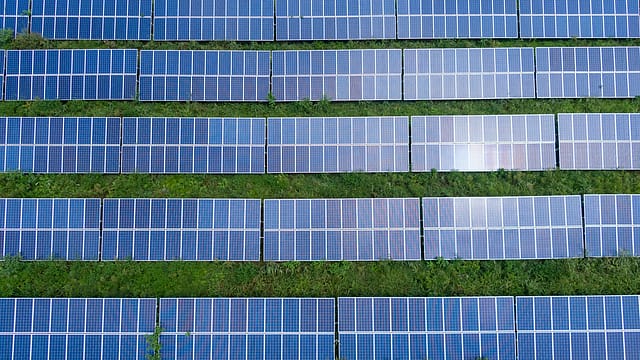Falling module price to spur record solar addition this fiscal: Crisil
ADVERTISEMENT

A steady decline in the price of solar modules since October 2022 will boost the internal rate of return of 45 gigawatts of utility-scale solar project pipeline awarded since fiscal 2021, according to Crisil.
This, in turn, will propel solar capacity implementation to its fastest annual pace of 16 GW this fiscal, the ratings agency says.
Implementation had slowed in FY22 and FY23 due to the Covid-19 pandemic-related disruptions and challenges stemming from the efforts to protect the Great Indian Bustard bird, for which extensions were given by the relevant authorities. That, along with an upsurge in module prices, had delayed execution.
Now, with module prices once again falling, the end of pandemic-related disruptions and clarity regarding the protection process for the Great Indian Bustard (bird diverters to be installed on extant and new low-voltage transmission lines) execution is expected to be hastened by fiscal 2026, the ratings agency says.
The trend of falling module prices reversed in the last quarter of fiscal 2021 as higher prices of key raw materials such as polysilicon and aluminium drove up the cost. This impacted the returns’ profiles of around 20 GW of projects auctioned in fiscals 2021 and 2022 — included in the 45 GW of solar project pipeline cited above — as developers had factored in the falling module prices when bidding for capacities. Module prices are typically tied up closer to the installation period of 6-9 months.
December 2025
The annual Fortune 500 India list, the definitive compendium of corporate performance, is out. This year, the cumulative revenue of the Fortune 500 India companies has breached $2 trillion for the first time. Plus, find out which are the Best B-schools in India.
If implemented as per schedule, the average IRR of around 20 GW projects auctioned during fiscals 2021 and 2022 could have fallen to as low as 5%, with some even becoming unviable on a standalone basis, says Ankit Hakhu, director, Crisil Ratings. However, the pandemic-linked extension in the scheduled commissioning dates provided relief to these projects, giving developers a chance to defer module purchases.
India is expected to meet its 2030 target to have half of its electricity capacity be non-fossil well before the end of the decade, according to the IEA's new World Energy Outlook 2023. If the new solar PV module manufacturing capacity under the PLI programme comes fully online by 2026, it will progress the solar capacity in India to well over what is needed by the end of this decade, the IEA said.
India's module manufacturing capacity is expected to reach 95 GW and cell capacity is expected to grow seven-fold to 32-35 GW by the end of 2025.
Now that module prices have softened — down around 30% as of September 2023 compared with the average last fiscal — project IRRs may improve by 300-500 basis points (bps) to 9%, on average. "Softer module prices will also benefit 25 GW of capacities bid during and since fiscal 2023. These 25 GW of projects had higher bid tariffs (Rs 2.5-2.7 per unit) compared with those awarded in prior fiscals (below Rs 2.5 per unit), as they factored in higher module costs, and should see their IRR improve 200-300 bps now that module prices have eased," says Varun Marwaha, associate director, Crisil Ratings.
